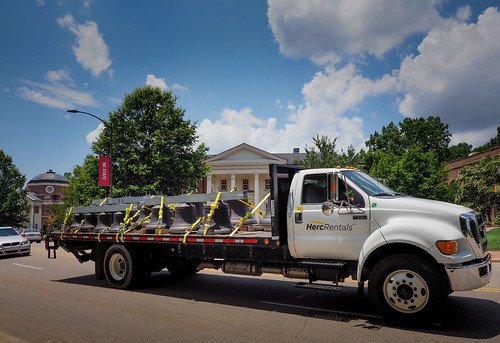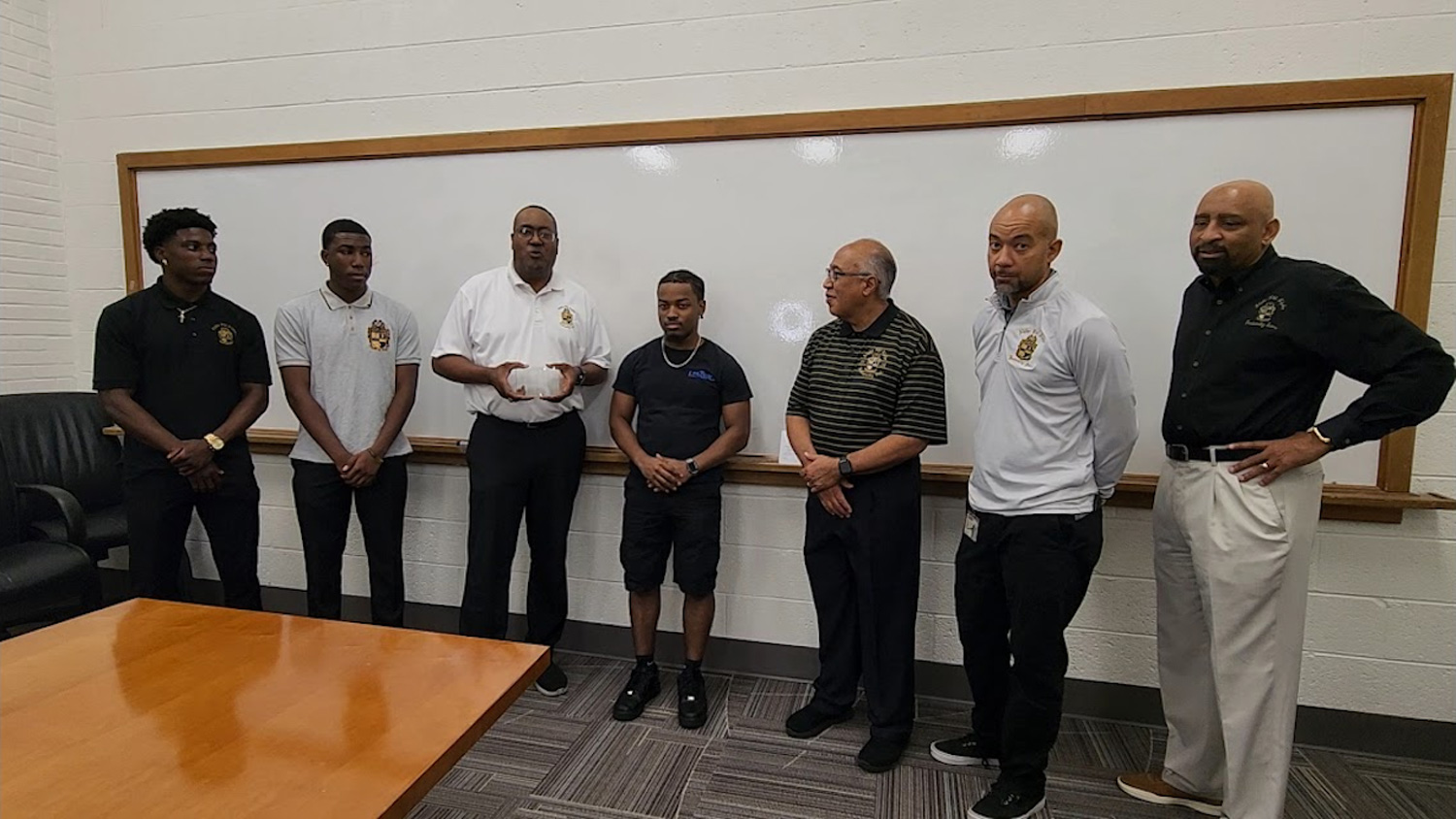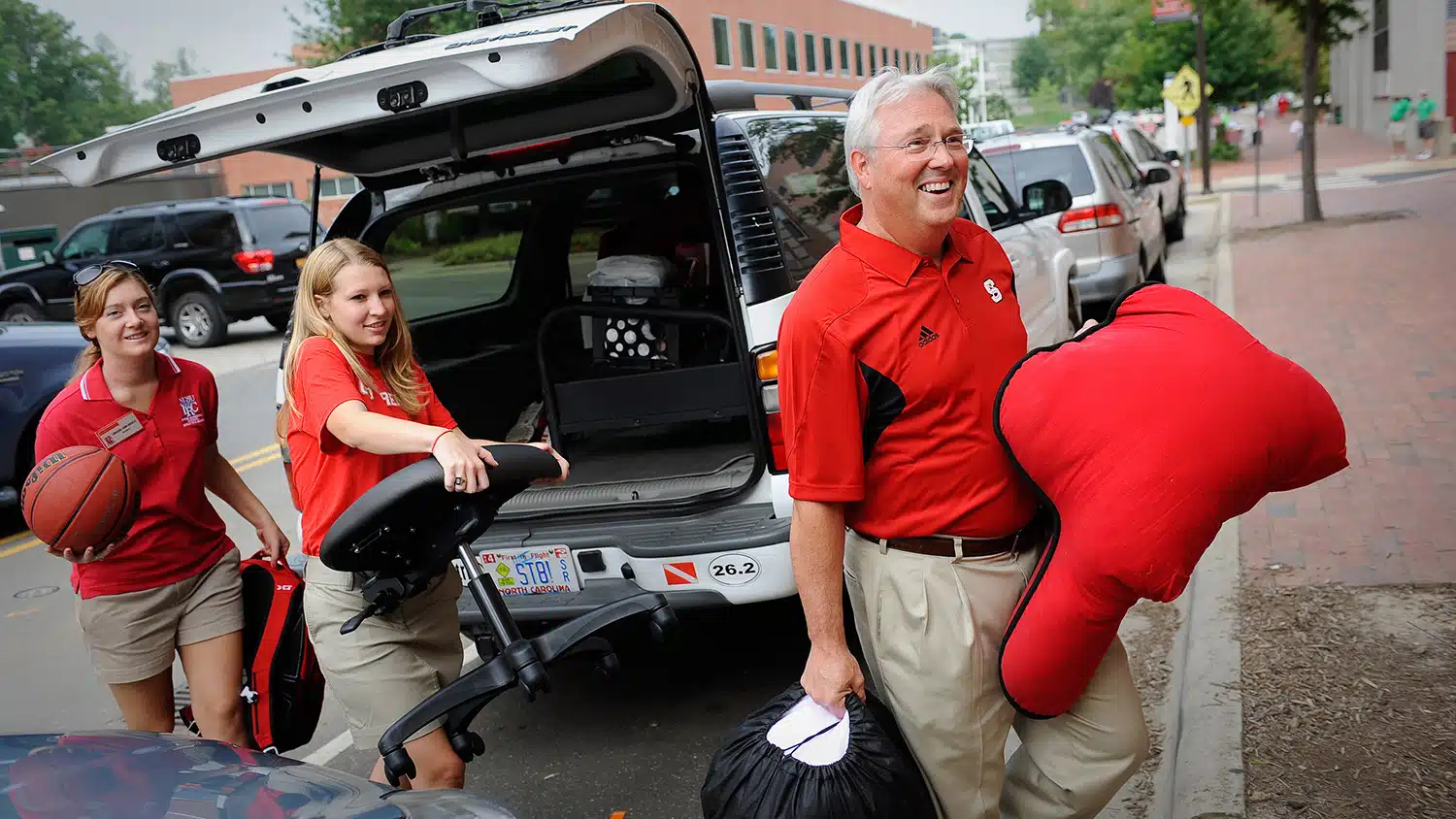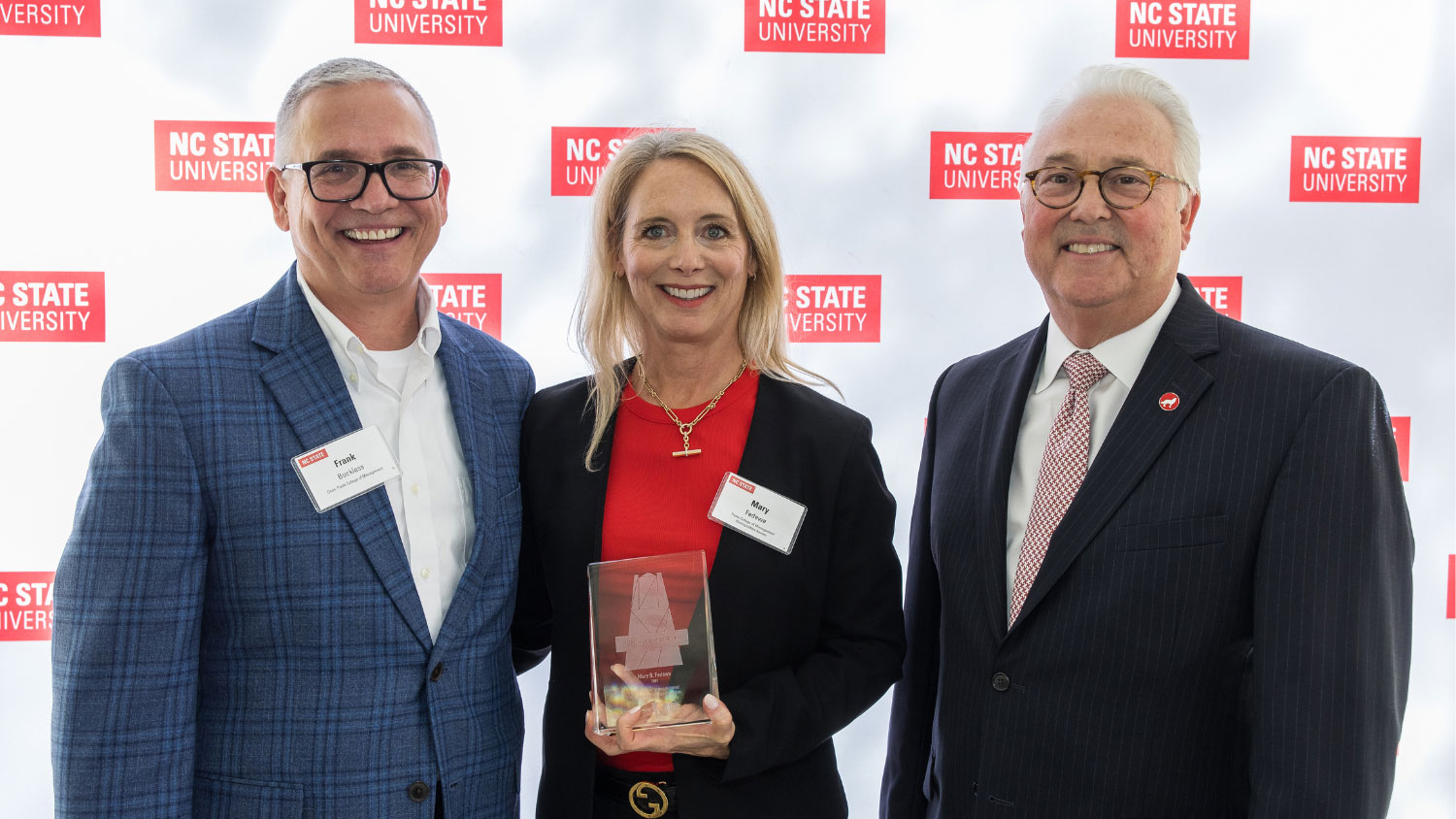At Long Last, Bells

Around 5 p.m. on Tuesday, June 23, 2020, a long-awaited sound finally emanated from the top of NC State’s Memorial Belltower.
One by one — against a sky that had just cleared of threatening, late-afternoon summer clouds — a crane lifted four large bronze bells up from a staging area inside a construction fence then down into the tower’s belfry.
As each bell entered the top of the tower, where three or four workers stood more than a hundred feet above a fairly quiet campus ready to grab and maneuver it, Ben Sunderlin rang it briefly using a hammer.
The installation of real bells: a simple phrase yet a historic moment nearly a century in the making.
“I wanted to let each bell sing for a moment to mark the occasion. This is such a momentous addition to campus, and we are very honored to be making this instrument for NC State,” said Sunderlin, a campanologist and the founder and owner of Virginia-based B.A. Sunderlin Bellfoundry along with his wife, Kate.
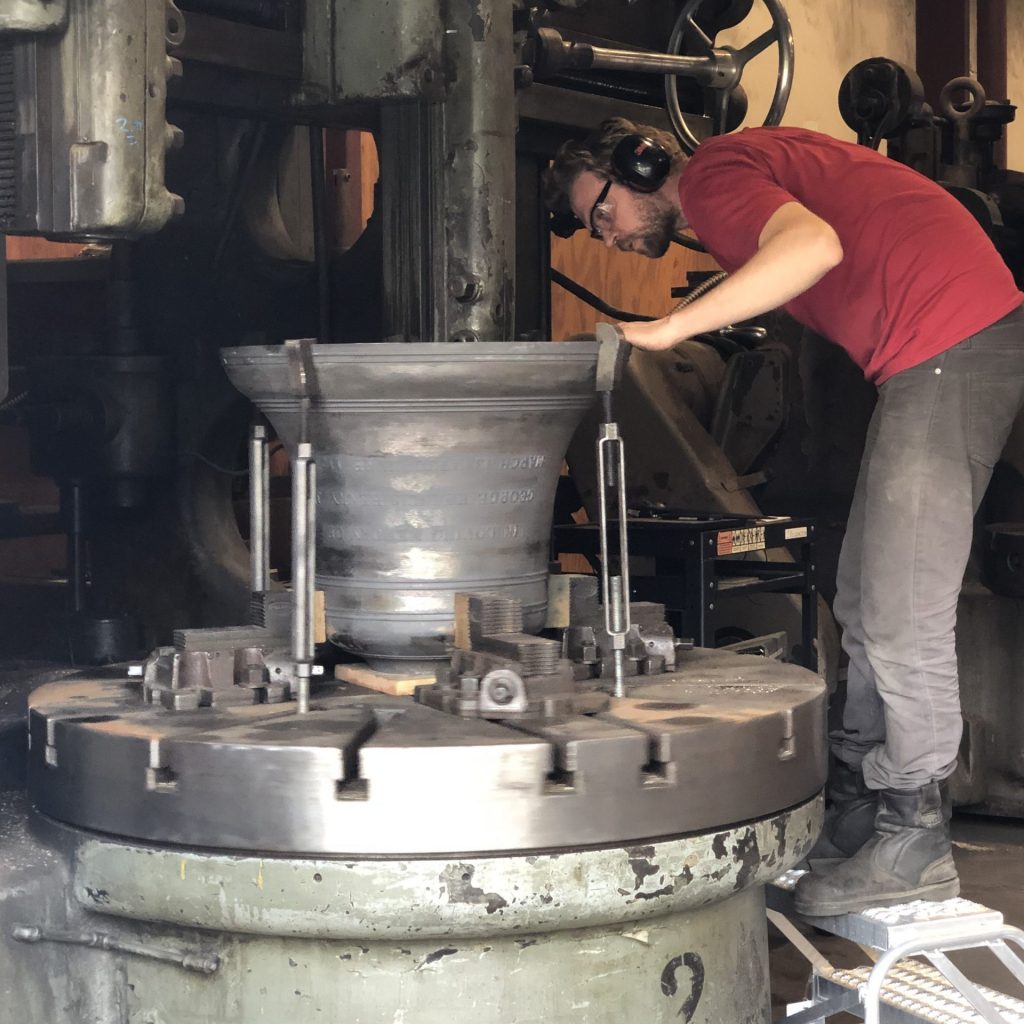
The previous afternoon and that morning, Sunderlin and his crew had completed the rigging for these bells. First, they used the crane to fly in two huge steel corner posts for the bell frame, followed by cross beams – think of a really big ladder. Each bell was secured into the frame after flying up.
On Wednesday, 14 more bells entered the belfry at midafternoon. These traveled upward in groups of three and four already attached to headstocks, beams that are part of and integral to the frame design.
Eventually, 55 bells will make up the Belltower’s carillon. This group of 18 rolled south on I-95 and onto campus first via a 24-foot flatbed truck and a smaller trailer for a reason. They are the largest, with the four installed individually ranging from 36.5 to 45 inches in diameter; the smallest installed in the June group clocked in at 18.25 inches.
Those bells had to go into the belfry over the top because they wouldn’t fit through a final upward hatch that’s 18 inches wide. (The tower’s roof was temporarily removed earlier in the month for the installation and put back in place this week.) Remaining bells will fit through the hatch and thus will be carried up new interior tower stairs to be fitted into the frame.
Every time an individual bell or bell on a headstock came home and sounded its brief note, scattered onlookers taking photos and videos cheered.
The spectators wore face coverings and stood several feet apart. The COVID-19 pandemic prevented any arrival ceremony; bell donors and honorees are getting sneak peeks and quick unmasked photos with their individual bells before each goes into the tower.
The Belltower’s story always has intertwined with broader history.
Conceived in 1920 to honor university alumni lost in World War I, its cornerstone laid in 1921, the tower was largely completed in the 1930s by the Works Progress Administration before additional elements were added in the 1940s. The architect, William Henry Deacy of New York City, was involved with the project from its inception along with Carroll Mann, the engineering professor who led the building committee.
But the university’s alumni base was much smaller then, and many were farmers. The Great Depression and two world wars disrupted fundraising despite dedicated efforts by students, alumni and faculty. University money was never really intended to be used. The team eventually gave up on adding bells and, in the late 1940s, installed a speaker and electronic carillon system that was updated a few times.
A decade ago, a grassroots fundraising effort led by then-student Matt Robbins and the class of 2010 helped revive interest in finishing the tower with bells; dozens of gifts came in, and five bells bought during that campaign were among the first group into the tower. In 2017, a transformational gift from Bill (’81) and Frances Henry to the university’s Think and Do the Extraordinary Campaign ensured that an extensive, $6.5 million Belltower completion and restoration project could advance.
The process of putting bells into the tower reflects not only history, though. It’s also both science — structural engineers, for example, worked with the foundry team to ensure that about 10 tons of frame and bells would be supported and up to code — and an art.
A Fiery Start
NC State’s bells were born in fire.
On a very warm Friday at the end of September, Sunderlin and four other men huddled in a cavernous building, between an open warehouse door and a sandy pit several feet square.
Sunderlin gestured and gave instructions much like a football quarterback calling plays, his back to a glowing, humming furnace. Big fans near the ceiling fought the heat.
With their helmets, safety shields, leather aprons, gloves and boots, not to mention forklift, the crew also looked a bit like stereotypical villains in a vintage James Bond movie.
All morning, some 1,600 pounds of metal, a bronze consisting of at least 80% copper mixed with tin, had been cooking. Slightly before noon, the foundry crew maneuvered and tipped a large cauldron into a vat on a trolley, releasing a stream of hot metal.
After one crew member removed a plywood cover from the pit, another positioned a forklift into perfect position to tip the lava-like metal through a gating system into a bell mold buried in the pit. Sparks and small bits of bronze hit the surrounding sand and concrete floor throughout this process, accompanied by the sound of bubbling metal. The hot air smelled like multiple campfires.
The metal had heated to 2,000 degrees Fahrenheit. Workers waited for it to cool to 1,800, testing the temperature periodically, before sending it into the mold for what was destined to become the second-largest bell in the Memorial Belltower, at 40.5 inches in diameter and eventually to peal a dulcet G note.
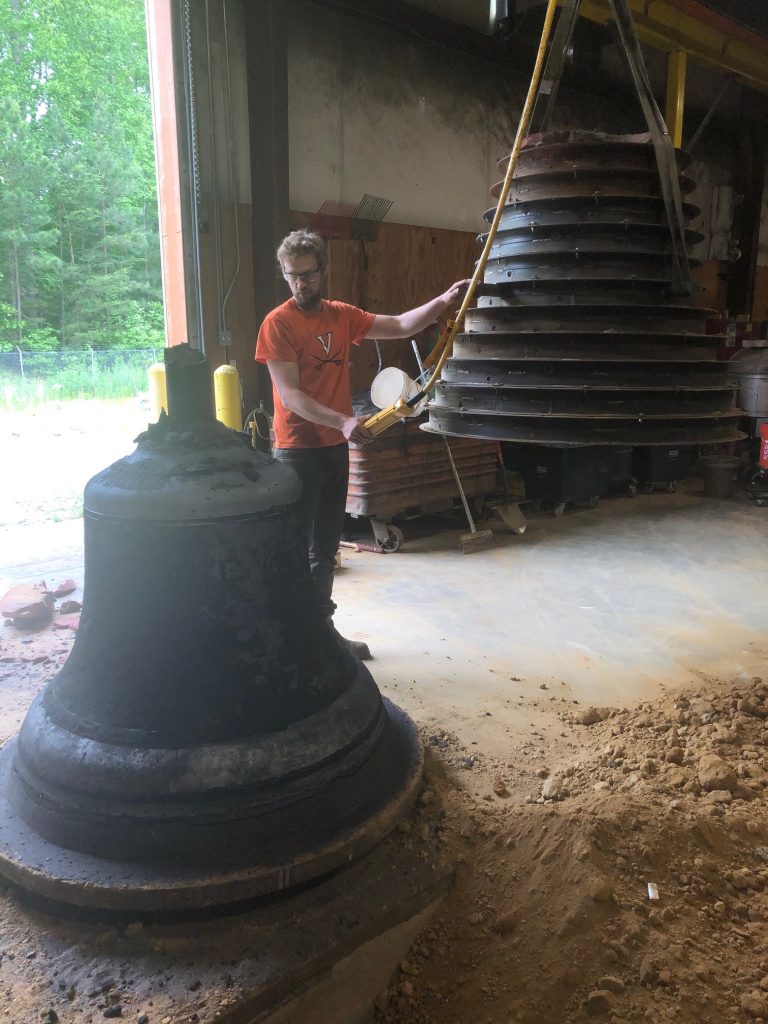
The bell would remain in the pit for a couple of days to cool before being moved to a repurposed shipping container. “Pouring days” happen about once a week or biweekly, with up to four bells poured on a given day.
In this nondescript industrial facility in Ruther Glen, Virginia, Sunderlin began this process of producing the 55-bell carillon for NC State last summer. The carillon will be the largest in North Carolina, and it’s the biggest project yet undertaken by the foundry, which the Sunderlins established about five years ago.
Filled with hand tools of every description as well as big equipment like lathes and kilns, the foundry is a full-service operation. Its team is completing every step of the bell-making process as well as building the metal frame for the belfry and the wooden console. The console, complete with batons and foot pedals, is where a carillonneur can sit and play the carillon somewhat like an organ.
As a side task, they’re even fashioning new 45-inch bronze bowls that will go atop the four lighting fixtures outside the Belltower, to align the torchieres better with the tower’s design era and to allow for white and red exterior lighting.
While casting is the most dramatic and photogenic part of making a bell, it’s just one step of a complex process.
An Old Process, a Young Couple
B.A. Sunderlin Bellfoundry is located in a wooded area north of Richmond, where nearby horse farms provide a key ingredient in the first step of a swept-loam process of making bells that dates to the Middle Ages.
The foundry is certainly rare, and likely unique in the United States, in using this traditional approach. Most foundries now use a resin sand-casting technique viewed as quicker and often more economical.
There are three key stages in the Sunderlins’ process — molding, casting and finishing — followed by installation. There are substages as well. Finishing, for example, involves both tuning and polishing.
The foundry’s lobby serves as a mini-museum about the craft, with displays including prints showing European bellmakers at work in the 1700s and 1800s.
Kate Sunderlin leads brief tours of this area, providing information that begins with the general history of making bells and moves to specifics of what happens in the back of the building. Her pursuit of a doctorate in art history brought the family east.
She and Ben met in graduate school at Notre Dame. As an undergraduate at Indiana University-Purdue University at Indianapolis, Ben had studied sculpture in the Herrin School of Art. He was working in bronze when he received a grant to do field research internationally. In England, at a foundry dating to the 1800s, he became fascinated with the traditions and methods of making bells.
“I fell in love with it,” he said. “It was just amazing. The craft was pretty common in the 1500s and 1600s, passed down through generations, but it started to fade away. By the end of World War II, in the United States, most foundries were gone. Most bell making happens in Europe now.”
Working on his master’s degree, he studied bell making in France, too, gaining mentors and collaborators along the way. The couple is now passionate about preserving and teaching the craft. As a small shop, they have trained most of their employees to handle most steps in the process, although each also specializes in an area such as molding, woodworking or design. Outside consultants occasionally come in.
It’s a niche business, but there is demand. In addition to making bells, the foundry services, maintains and tunes bells scattered across the country in churches, temples, schools and municipal buildings. Now and then, it does other jobs like casting cannons.
Kate described bell creation as a constant process of moving from positive to negative and vice versa.
Before each bell is poured, a mold or core is created. This baseplate involves the use of bricks and a mud compound, or loam, to build up the mold.
Ingredients in B.A. Sunderlin Bellfoundry’s loam include sand, clay, manure from the aforementioned horse farms and human hair cleaned up from nearby salons as a binding agent.
“We’re really proud to use local materials,” Kate Sunderlin said.
These molds are built to be slightly larger than the eventual bell they will produce. Workers “sweep” around a central point using flat wooden profiles that create the shape. This sweep can also add lines that add decoration and styling characteristic of Sunderlin bells.
The interior (core) and the exterior (cope) of the mold are sleeked in graphite, closed together and buried in the pit in preparation for casting.
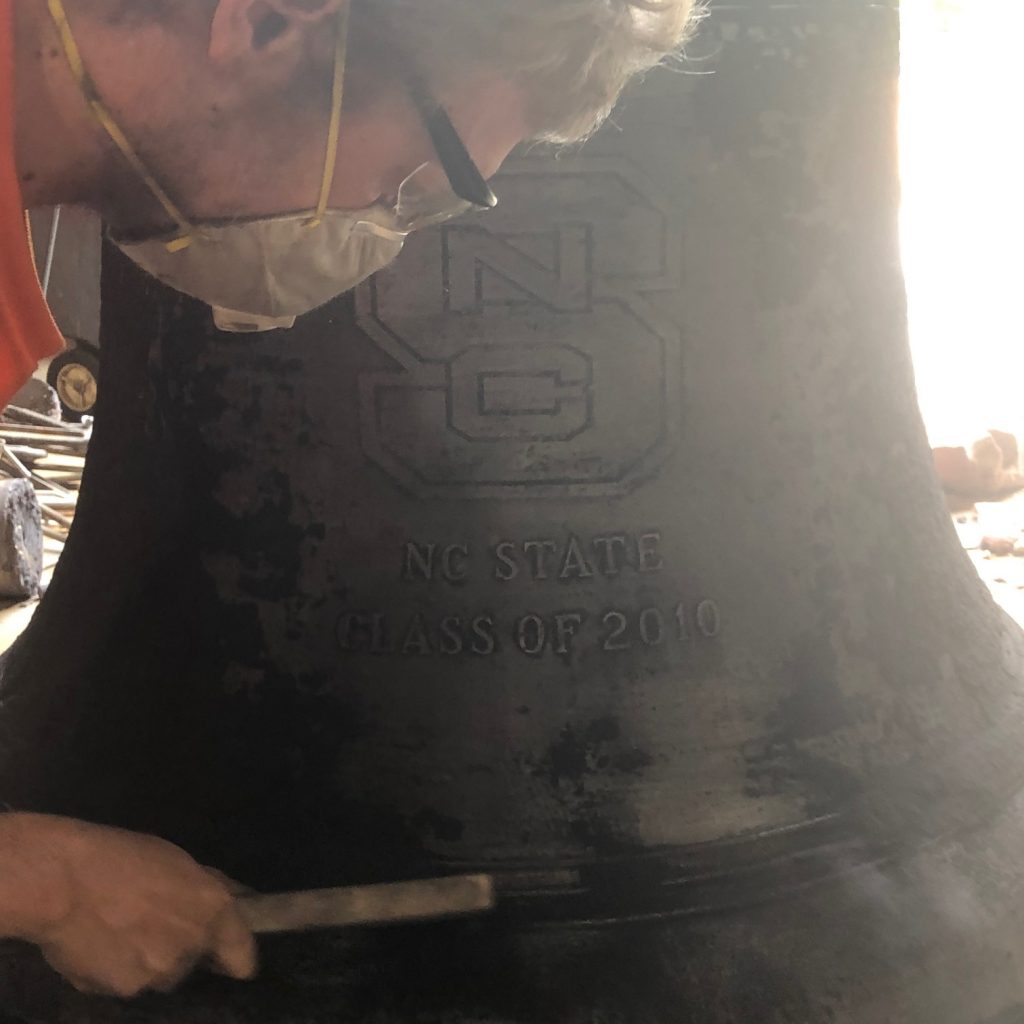
For most of NC State’s bells, molded in the English method, inscriptions — memorial and honorary wording chosen by bell donors — were stamped into the loam. This must be done in reverse given the molding process. The largest bell, bought by the class of 2010 and with nearly a hundred names on it, was inscribed in a different lost-wax method.
During casting, molten bronze flows fast and smooth into the crevices of a mold before it cools. A pipe in the pit allows the escape of gas emitted as the loam burns. After a bell cools, the crew digs it up and breaks apart the mold.
Once bells are molded, cast, cooled and shaken from their molds comes the trickiest part: tuning.
Tuning brings the five parts of a bell’s sound that establish its overall timbre — the hum, prime or fundamental, tierce or minor third, quint or perfect fifth, and nominal (naming note) — into agreement with one another. It’s achieved by removing certain amounts of metal from the interior of each bell on a lathe or vertical boring machine.
Ben Sunderlin personally tunes each bell, removing metal at different points corresponding with the different tones within the note sounded when the bell is rung. He relies on his ear and a computer program.
Everything can go perfectly to this point, but if too much metal is removed from a certain spot, the bell might have to be completely remade. There is no replacing metal once removed. The five partials are tuned to extremely close tolerances in order to ensure that each bell sounds according to client specifications.
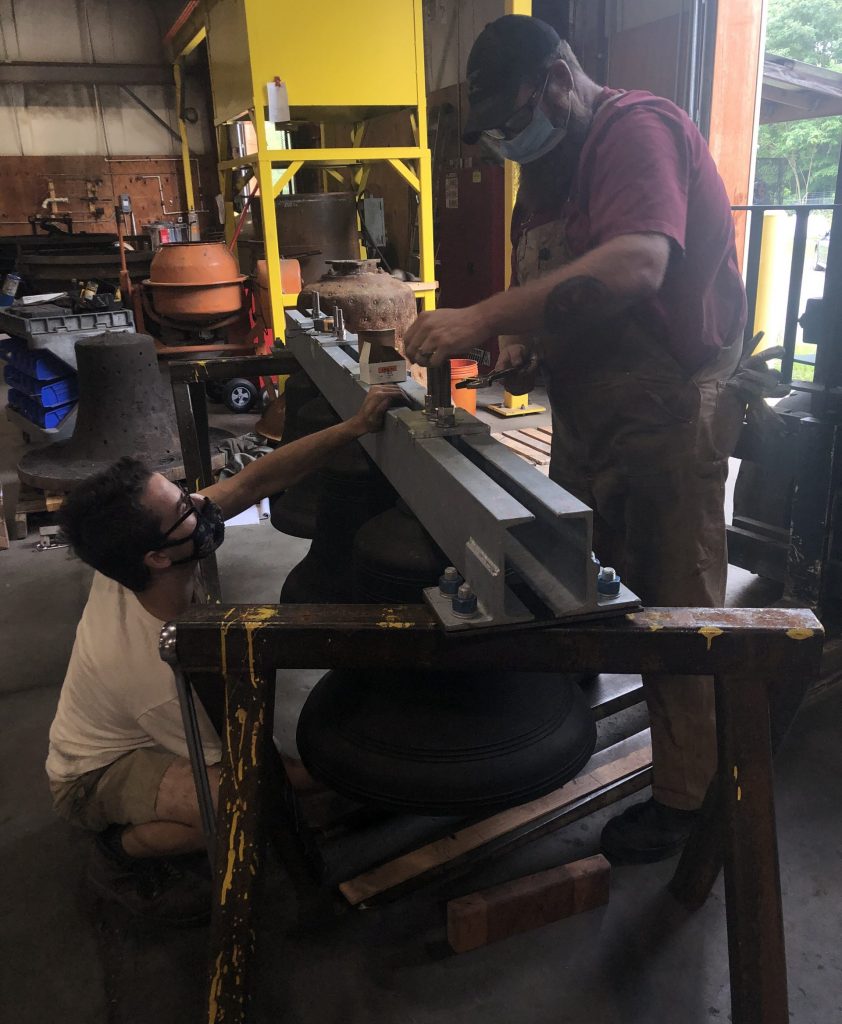
After study and consideration, the five bells cast as part of NC State’s earlier Finish the Belltower campaign were melted down and recast to ensure they would harmonize perfectly with the newer bells. (A few others bought during that campaign had not yet been cast.)
Early in American history, Kate said, most bells were part of church chimes rather than carillons; a chime is defined as fewer than 23 bells. These instruments would use one octave of notes to play chimes, hymns and the like.
Carillons, which became more common in the 20th century, typically span four to five octaves, providing more potential for musical arrangements.
More to Come
Before bells arrive at NC State, the Sunderlin crew finishes them by essentially polishing their surface then blacking them with a stovetop finish. Bells can be finished in any number of ways, but historically, English foundries finished theirs in this manner. The bells are lighter and shinier on the inside due to tuning (which removed metal) and because there is no need to finish the insides in the same way.
Over the next few weeks, they will complete the remaining bells, hardware ranging from tiny pins to turnbuckles and crank wires, and ductile iron bell clappers for all 55 bells and the console.
The console, or clavier, a Sunderlin standard design made of red oak with clear polyurethane finish, is being assembled and tested at the foundry before sections are carried up the Belltower steps. Two of the four console posts of this keyboard-like instrument are being carved to look like the tower itself. Electronic controls also will allow remote and somewhat automated ringing.
Carillonneurs, those who play carillons, are relatively rare. Much like bell founding, it is a practice born of passion, Kate Sunderlin said. A players’ guild in North America works to spread the art and to educate others. Many universities with carillons incorporate them into the music department.
Also rare are carillons with 55 bells like NC State’s. The number is not unusual in the way it allows for a full four octaves of bells; in this case, 48 bells, as the low C# is missing, which goes up another half octave beyond the upper C to a G. But, the Sunderlins said, it is unusual in that only two other instruments in North America have 55 bells — one in Connecticut and one in Niagara Falls, Canada. Carillons at Raleigh’s Holy Name of Jesus Cathedral and Durham’s Duke University Chapel have 50 bells. There are only 30 to 35 instruments bigger than NC State’s in North America (out of about 190 total).
The university’s smallest bell measures 6 inches in diameter and weighs 16 pounds (playing note C and inscribed with the wolf ears hand sign). The largest bell, the class of 2010’s, is a 45-inch F note tipping the scales at more than 1,800 pounds.
Historical records indicate that Deacy’s first design called for a chime, but alumni and others quickly began talking competitively about a larger instrument to outstrip those in other area belfries.
“You could not fit any more bells in this tower even if you wanted to,” Kate Sunderlin said. “It’s stuffed to the gills.”
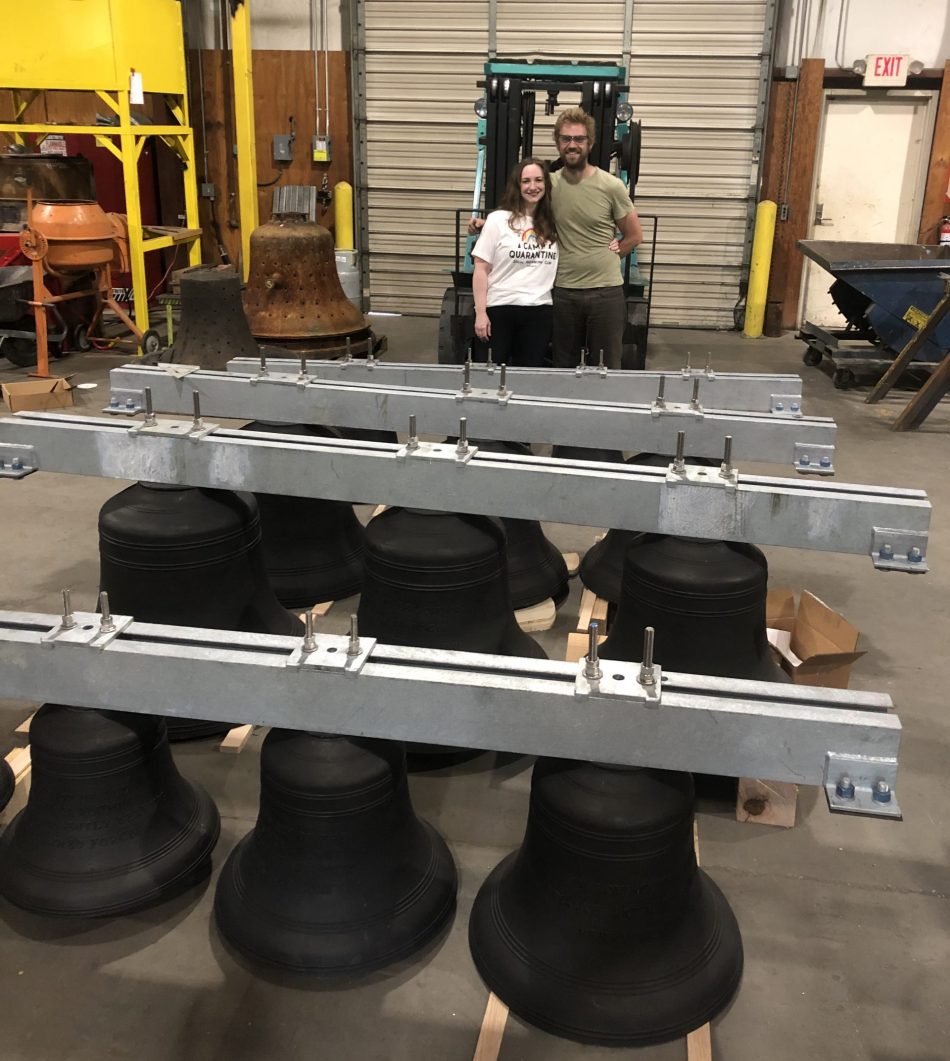
Passersby should be alert for more ringing when remaining bells are installed, likely in August.
The bells will last for many years. Water and weather will affect them slightly, and they will need regular maintenance checks.
The Sunderlins love their job.
“And I love the Wolfpack’s passion for all things NC State — the genuine joy, excitement, encouragement and interest that have greeted us whenever we get to speak to a member of the Pack about their bells,” Kate said. “This is a banner project for us, our first carillon, and we will always be grateful for this opportunity. Because it was the first, this tower will always hold a special place in our hearts, too. We are really, really proud, and just pleased as punch to get to put bells in this tower.”
The full Memorial Belltower at Henry Square project is slated to be completed late this year, with a rededication currently planned for spring.
- Categories:


